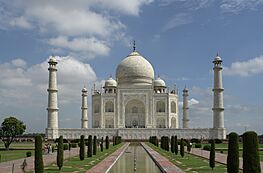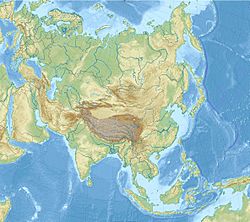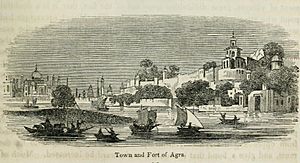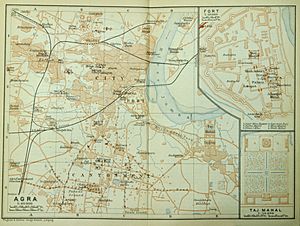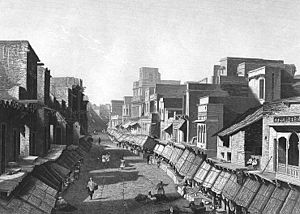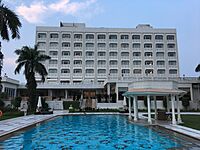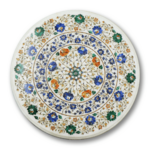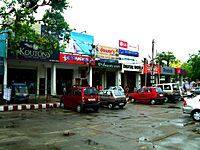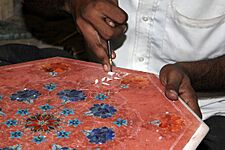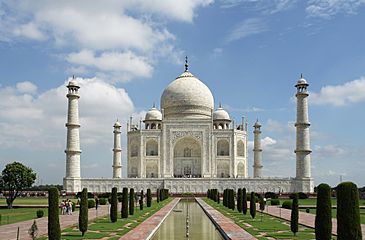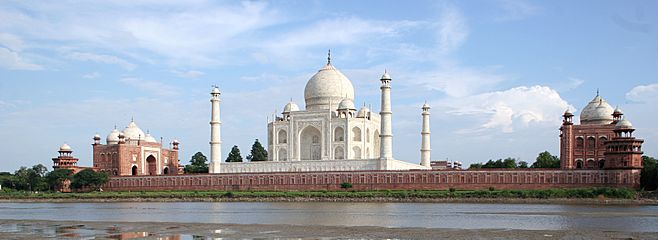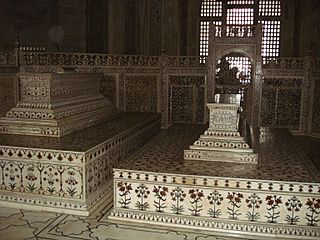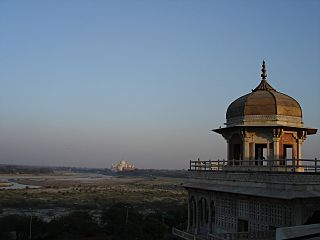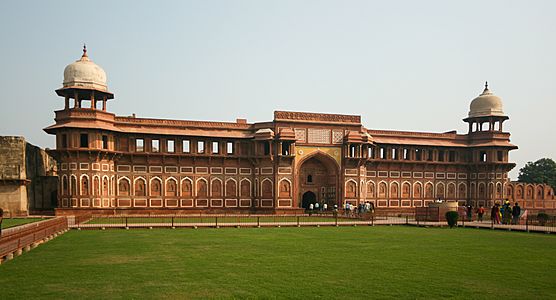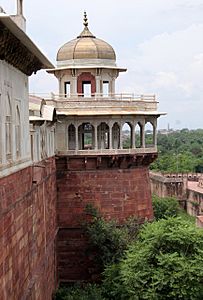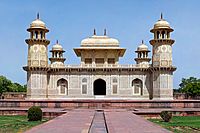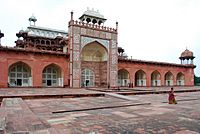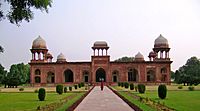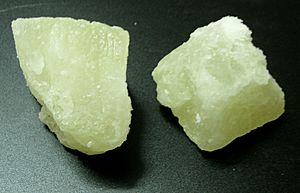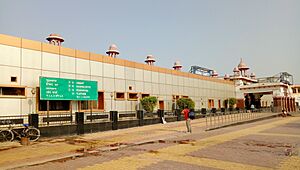Agra facts for kids
Quick facts for kids
Agra
|
|
|---|---|
|
From top, left to right:
Taj Mahal; Jaswant Ki Chhatri; Tomb of I'timād-ud-Daulah; Akbar's tomb; Guru ka Tal Gurdwara; and Agra Fort |
|
| Nickname(s):
The Taj City (Taj Nagari)
|
|
| Country | |
| State | |
| Division | Agra |
| District | Agra |
| Government | |
| • Type | Municipal Corporation |
| • Body | Agra Municipal Corporation |
| Area | |
| • Metropolis | 121 km2 (47 sq mi) |
| Elevation | 170 m (560 ft) |
| Population
(2011)
|
|
| • Metropolis | 1,585,704 |
| • Rank | 23rd |
| • Metro | 1,760,285 |
| Language | |
| • Official | Hindi |
| • Additional official | Urdu |
| • Regional | Braj Bhasha |
| Time zone | UTC+5:30 (IST) |
| Pincode |
282001-282009
|
| Telephone code | 0562 |
| Vehicle registration | UP-80 |
| GDP Nominal | $ 1.53 Billion (2019-20) |
| Sex ratio | 875 ♀ / 1000 ♂ |
| Literacy | 73.11% |
Agra is a famous city in Uttar Pradesh, India. It sits on the banks of the Yamuna river. It's about 230 kilometers (143 miles) southeast of Delhi, India's capital. With about 1.6 million people, Agra is one of the biggest cities in Uttar Pradesh.
Agra became very important during the time of the Mughal Empire in the 1500s. It was the capital city for powerful Mughal emperors like Babur, Akbar, and Shah Jahan. During this time, Agra became a hub for learning, art, trade, and religion. Many famous buildings were constructed, including the Agra Fort and the amazing Taj Mahal. The Taj Mahal was built between 1632 and 1648 by Emperor Shah Jahan to remember his wife, Mumtaz Mahal.
Later, as the Mughal Empire weakened, the city was controlled by different groups before the British took over in 1803. After India became independent, Agra grew into an industrial city. It's now a very popular place for tourists, known for its beautiful monuments, shoe-making, and leather goods. The Taj Mahal and Agra Fort are both UNESCO World Heritage Sites. Agra is also famous for its delicious Mughlai food. It's part of the "Golden Triangle" tourist route, along with Delhi and Jaipur.
Contents
What's in a Name?
The name Agra has a few possible meanings. One idea is that it comes from the Hindi word agar, which means "salt-pan." This is because the soil in the area used to be salty, and salt was made there by drying out water.
Another idea comes from old Hindu stories. The Sanskrit word agra means "the first of many groves." It refers to the forests where the god Krishna played. So, Agravana would mean "grove forest."
During the Mughal era, Agra was also called Akbarabad. Emperor Shah Jahan gave it this name to honor his grandfather, Emperor Akbar.
Agra's Story
Early Days
Agra has a very long history, going back to ancient times. But its important historical period really began with Sikandar Lodi. In 1504–1505, Sultan Sikandar Lodi, an Afghan ruler, rebuilt Agra and made it his government's main city. He chose a spot on the east side of the Yamuna river. Agra then grew into a busy town with royal families, traders, scholars, and artists. It became a major center for Islamic learning in India.
Sikandar Lodi also founded the village of Sikandra nearby. He built a beautiful red sandstone building there in 1495. Later, Emperor Jahangir turned it into a tomb for Akbar's wife, Mariam-uz-Zamani.
After Sikandar Lodi died in 1517, his son, Sultan Ibrahim Lodi, ruled from Agra. But in 1526, he was defeated and killed by Babur, the founder of the Mughal Empire, in the First battle of Panipat.
The Golden Mughal Era
Agra's most famous period started with the Mughals. It was the main city and capital of the Mughal Empire until 1658.
Babur, the first Mughal emperor, took over Agra in 1526. His son, Humayun, found a famous diamond called the Koh-i-Noor there. Babur loved gardens and created the first formal Mughal garden in India, the Aram Bagh, along the Yamuna river. He wanted to make Agra his capital, even though he found the area a bit plain at first. He built many gardens, palaces, and baths.
Babur was followed by his son Humayun. But Humayun was defeated by Sher Shah Suri in 1539. Sher Shah Suri ruled for a short time. Then, Akbar took back the region in 1556.
Under Akbar (who ruled from 1556–1605), Agra became incredibly famous. Akbar built the modern city of Agra on the right bank of the Yamuna. He made it a huge center for politics, culture, and trade. Akbar also built the strong walls of the Agra Fort. He even built a new capital city, Fatehpur Sikri, about 35 kilometers (22 miles) from Agra, but it was later left empty.
By the time Akbar died, Agra was one of the biggest cities in the East. A traveler named Ralph Fitch visited in 1585 and said Agra and Fatehpur Sikri were "much greater than London, and very populous."
Agra continued to grow under Akbar's son, Jahangir (who ruled from 1605–27). Jahangir loved plants and animals and built many gardens. Akbar's tomb at Sikandra was finished during his rule. The Jahangiri Mahal in Agra Fort and the tomb of Itmad-ud-daulah were also built then.
But it was Shah Jahan (who ruled from 1628–58) who brought Agra to its greatest glory. Shah Jahan loved architecture. He gave Agra its most famous monument, the Taj Mahal. He built it for his beloved wife, Mumtaz Mahal. The Jama Masjid and other important buildings inside the Agra Fort were also built by him.
In 1648, Shah Jahan moved the capital to Delhi. His son, Aurangzeb, also moved the entire court to Delhi in 1658. After this, Agra started to decline, but it still remained an important city.
Later Times
As the Mughal Empire weakened, different groups took control of Agra. First, the Marathas had influence, and then the British East India Company took over in 1803. From 1836 to 1858, Agra was the capital of the North-Western Province under British rule.
Agra was also a center during the Indian rebellion of 1857. When news of the rebellion reached Agra, many Europeans moved into the Agra Fort for safety. Even though there was some disorder, the British managed to regain control. The uprising in Agra was not as big as in other cities like Delhi. After this, the British ruled Agra until India gained independence in 1947.
Modern Agra
After India became independent, Agra became part of Uttar Pradesh. It has grown into an industrial city and a major tourist spot. The Taj Mahal and Agra Fort were named UNESCO World Heritage Sites in 1983. Many world leaders, like US Presidents and Queen Elizabeth II, have visited the Taj Mahal.
Agra is also where the Radhaswami Faith began, which has millions of followers worldwide. The city is part of important tourist routes, like the "Golden Triangle" with Delhi and Jaipur.
Geography and Weather
Geography
Agra is mostly a flat plain, with some small hills in the southwest. The main rivers are the Yamuna and Chambal. Farmers in the area grow crops like millet, barley, wheat, and cotton. The old city of Fatehpur Sikri is about 40 kilometers (25 miles) southwest of Agra.
Agra is about 210 kilometers (130 miles) from New Delhi and 336 kilometers (209 miles) from Lucknow, the state capital. The city is about 170 meters (558 feet) above sea level.
Climate
Agra has a climate with warm winters, very hot and dry summers, and a monsoon season. Because it's close to the sandy Thar Desert, Agra is quite dry and has bigger temperature changes than places further east. A hot west wind called Loo blows strongly in April, May, and June. This wind can be very dangerous. The highest temperature ever recorded in Agra was 48.6°C (119.5°F) in May 2024.
The monsoon rains usually start in early July and end in mid-September. While there's good rain, it's not as heavy as in some other parts of India. The weather gets cooler by mid-October. In winter, the area around Agra often has thick fog, which can cause delays for trains and flights.
Agra also faces challenges with air pollution. It has one of the worst AQIs (Air Quality Indexes) in India. However, in a recent survey (Swachh Vayu Survekshan 2024), Agra was ranked the 3rd best "National Clean Air City" in its category.
Environment
The Taj Mahal has been affected by air pollution and dirty water from the nearby Yamuna river. Its white marble is turning yellow and green because of the polluted air. The Yamuna River is one of the most polluted rivers in the world. Agra is a big source of this pollution, with many drains emptying untreated waste into the river. This pollution has caused problems for the Taj Mahal, including green slime from bugs and damage to its foundation.
Less than 7% of the Agra district is covered by forests. The main wildlife area nearby is Keetham Lake, also known as Sur Sarovar Bird Sanctuary. This lake is home to many kinds of birds. Inside this sanctuary is the Agra Bear Rescue Facility. This is India's first place to help 'dancing' bears. It has rescued over 620 sloth bears that were forced to 'dance' for entertainment, which is now illegal.
People of Agra
| Historical population | ||
|---|---|---|
| Year | Pop. | ±% |
| 1871 | 142,700 | — |
| 1881 | 160,200 | +12.3% |
| 1891 | 168,700 | +5.3% |
| 1901 | 188,300 | +11.6% |
| 1911 | 185,400 | −1.5% |
| 1921 | 185,500 | +0.1% |
| 1931 | 125,300 | −32.5% |
| 1941 | 284,100 | +126.7% |
| 1951 | 375,700 | +32.2% |
| 1961 | 462,000 | +23.0% |
| 1971 | 594,900 | +28.8% |
| 1981 | 723,700 | +21.7% |
| 1991 | 891,800 | +23.2% |
| 2001 | 1,275,000 | +43.0% |
| 2011 | 1,585,000 | +24.3% |
Agra has about 1.6 million people, making it the fourth largest city in Uttar Pradesh. In 2011, there were 875 females for every 1000 males. The average literacy rate (people who can read and write) in Agra is about 73.11%.
| Religion in Agra city (2011) | ||||
|---|---|---|---|---|
| Religion | Percent | |||
| Hinduism | 80.68% | |||
| Islam | 15.37% | |||
| Jainism | 1.04% | |||
| Sikhism | 0.62% | |||
| Christianity | 0.42% | |||
| Buddhism | 0.19% | |||
| Other | 0.02% | |||
| Not Stated | 1.66% | |||
| Distribution of religions | ||||
Most people in Agra follow Hinduism (80.68%). The second largest religion is Islam (15.37%). Other religions like Jainism, Sikhism, Christianity, and Buddhism are also present.
City Services
Electricity in Agra is managed by a private company called Torrent Power and a state-owned company called DVVNL. Water for the city comes from treatment plants and groundwater. However, the Yamuna river, a major source, is very polluted, so the water quality can be poor. A project called Gangajal pipeline is bringing water from the Ganga river to improve the supply.
Many homes use cooking gas cylinders. Piped natural gas is also available in some areas.
Agra's Economy
Agra has a strong tourism industry because of the Taj Mahal and other historical buildings. Many people visit Agra each year. The city is also known for traditional crafts like Pietra Dura (marble inlay) and carpets.
About 40% of the people in Agra work in agriculture. Others work in the leather and footwear business or in iron foundries. Agra is famous for making shoes, with over 150,000 pairs produced daily. It's also known for leather goods, carpets, and embroidery work.
In 2018–19, Agra's economy was valued at about $1.53 billion, making it the 3rd richest city in Uttar Pradesh. Agra has also been doing well in city cleanliness rankings. In 2020, it ranked 16th nationwide for cleanliness.
The COVID-19 pandemic affected Agra's economy, especially tourism and the shoe industry. The tourism industry alone lost a lot of money due to restrictions.
Famous Buildings and Architecture
Taj Mahal
The Taj Mahal is a stunning mausoleum (a grand tomb) in Agra. Emperor Shah Jahan built it for his wife, Mumtaz Mahal, who passed away in 1631. It's located on the Yamuna River, about 1.6 kilometers (1 mile) east of the Agra Fort. The Taj Mahal is considered one of the best examples of Mughal architecture, which mixes Indian, Persian, and Islamic styles.
The complex includes the main gateway, beautiful gardens, a mosque, and the mausoleum itself with its four tall minarets. Construction began in 1632 and took 22 years to complete. Over 20,000 workers from different countries helped build it.
You can see the Taj Mahal from the Agra Fort, where Emperor Shah Jahan spent his last years as a prisoner. Verses from the Quran are written on the building. The main dome is very large, about 18 meters (60 feet) wide and 24 meters (80 feet) high. Inside, you'll find the tomb of Mumtaz Mahal. Shah Jahan's tomb is next to hers. The inside is decorated with detailed pietra dura (inlaid semi-precious stones).
Air pollution from factories and vehicles has damaged the Taj Mahal's marble. To protect it, some factories have been closed, and a special "Taj Trapezium Zone" has been created around it. This zone has strict rules to control pollution.
-
Taj Mahal and other buildings seen from across the Yamuna River
-
Tombs of Shah Jahan and his wife, Mumtaz Mahal
Agra Fort
The Agra Fort is a huge 16th-century fortress made of red sandstone. It's located by the Yamuna River in Agra. Emperor Akbar started building it in 1565. It served as the main government seat when Agra was the Mughal capital, and also as a military base and royal home.
The fort's red sandstone walls are about 2.5 kilometers (1.5 miles) long and 21 meters (69 feet) high. A moat surrounds them. There are two main entrances: the Delhi Gate and the Amar Singh Gate. The fort has many buildings inside, showing a mix of Persian, Timurid, Jain, and Hindu styles.
Important places inside the fort include:
- Jahangiri Mahal: The largest home in the complex, built by Akbar for his wives.
- Diwan-i-Am (Hall of Public Audience): Where the emperor would meet people and officials.
- Diwan-i-Khas (Hall of Private Audience): Used for special visitors.
- Musamman Burj: An octagonal tower where Shah Jahan's wife, Mumtaz Mahal, lived.
- Moti Masjid (Pearl Mosque): A beautiful mosque made entirely of white marble.
- Khas Mahal: The emperor's private home, decorated with precious gems.
- Sheesh Mahal (Palace of Mirrors): Its walls and ceilings are covered with thousands of tiny mirrors.
The fort also served as a prison for Shah Jahan. His son, Aurangzeb, kept him confined there from 1658 until Shah Jahan's death in 1666.
-
Musamman Burj, where Mumtaz Mahal lived
-
Amar Singh Gate, one of two entrances into Agra's Red Fort
I'timād-ud-Daulah's Tomb
Nur Jehan, the wife of Emperor Jahangir, built I'timād-ud-Daulah's tomb for her father, Mirza Ghiyas Beg. It's sometimes called the "Baby Taj" because it looks a bit like the Taj Mahal. This mausoleum is on the left bank of the Yamuna river. It's surrounded by a large garden with water channels and walkways.
The tomb is smaller than other Mughal tombs. It's known for its use of white marble, pietra dura (stone inlay), and beautiful latticework. These features were later used in the Taj Mahal. The walls are made of white marble from Rajasthan. They are decorated with semi-precious stones like cornelian, jasper, and lapis lazuli. These stones form designs of trees, wine bottles, or bouquets of flowers. Light comes into the tomb through finely carved marble screens.
Akbar's Tomb, Sikandra
Sikandra is where the great Mughal Emperor Akbar is buried. It's about 13 kilometers (8 miles) from the Agra Fort. The tomb has four stories and uses both marble and sandstone. Akbar started building it, and his son Jahangir finished it in 1613.
The tomb is in a large garden surrounded by walls with big gateways. The 99 names of Allah are written on the tomb. Nearby, you'll find the Tomb of Mariam-uz-Zamani, who was Akbar's favorite wife.
Other Interesting Places
Agra has many other interesting places, mostly from its Mughal past. These include:
- Jama Masjid: A large mosque built by Shah Jahan's daughter, Jahanara Begum, in 1648. It has an unusual dome.
- Chini Ka Rauza: Known for its Persian-style dome with blue glazed tiles. It's dedicated to Shah Jahan's prime minister.
- Aram Bagh: One of the oldest Mughal gardens in India, built by Emperor Babur in 1528. It's about 2.3 kilometers (1.4 miles) north of the Taj Mahal.
- Mehtab Bagh: Also called the 'Moonlight Garden', it's across the River Yamuna from the Taj Mahal.
- Keetham Lake: A nearby bird sanctuary, also known as Sur Sarovar Bird Sanctuary. It has many types of birds.
In the City
- Jahangiri Mahal
- Mina Mosque
- Moti Masjid (Agra Fort)
- Musamman Burj (Agra Fort)
- Nagina Masjid
- Shah Jahani Mahal
- Throne of Jahangir
- Dayal Bagh temple
- Aram Bagh, Agra
- Chini Ka Rauza
- Akbar's Church
- Jama Mosque, Agra
- Jaswant Ki Chhatri
- Mehtab Bagh
- Gyarah Sidi
- Black Taj Mahal
- Ram Barat
- Taj Mahotsav
- Paliwal Park
Around Agra
- Tomb of Mariam-uz-Zamani
- Fatehpur Sikri
- Buland Darwaza
- Panch Mahal, Fatehpur Sikri
- Tomb of Salim Chishti
- Ibadat Khana
- Maktab Khana
- Jama Mosque, Fatehpur Sikri
- Keetham Lake
- Bateshwar, Uttar Pradesh temples
Culture
Food
Agra is in the Braj region, and its local language is Braj Bhakha. Agra is known for its special food, which is similar to the food in nearby cities like Mathura and Vrindavan.
- Petha: A famous sweet made from ash gourd, available in many flavors.
- Dalmoth: A dry, spicy snack made with fried lentils, nuts, and raisins.
- Bedai: A puffy fried bread (like a kachori) with a spicy filling. It's usually served with spicy potato curry and yogurt.
- Chaat: A popular group of snacks, including dahi bhalla, raj kachori, samosas, and gol gappa.
- Paratha: A flatbread stuffed with potatoes, cauliflower, or cheese. It's eaten with yogurt, pickle, and chutney.
Taj Mahotsav
The Taj Mahotsav is a cultural festival and craft fair that started in 1992. It's held every year from February 18 to 27 in Shilpgram, near the Taj Mahal. Many Indian and foreign tourists visit this festival. One of its goals is to support local artists and craftspeople. It also offers art and crafts at fair prices. The theme for the 2020 festival was Sanskriti ke Rang, Taj ke Sang (Colors of Culture, with the Taj). The 2021 festival was canceled due to the COVID-19 pandemic.
Getting Around
By Air
As of April 2021, you can fly to Agra from cities like Mumbai, Ahmedabad, Bhopal, and Bangalore. The Agra Airport is controlled by the Indian Air Force.
By Train
Agra has seven railway stations. The main ones are Agra Cantonment and Agra Fort. Agra is a major railway hub and has many express trains, including the Rajdhani, Shatabdi, and Gatiman express. The Gatiman Express is India's first semi-high-speed train. It takes only 100 minutes to travel between Agra and Delhi. Luxury trains like the Maharajas' Express also stop in Agra.
By Road
Agra has several major bus stands that connect it to other big cities in northern India. It's a major junction for highways, with three national highways and two expressways starting from Agra. These include the Yamuna Expressway (connecting to Delhi) and the Agra Lucknow Expressway (connecting to Lucknow).
Buses are run by the UPSRTC. You can also use rickshaws to get around the city. Vehicles that cause a lot of pollution are not allowed near the Taj Mahal.
Agra Metro
Agra is building a Metro Rail system with two lines. One line will go from Sikandra to the Taj Mahal's east gate, passing through Agra Fort. The other line will connect Agra Cantt to Kalindi Vihar. The project was approved in 2017, and construction began in 2019.
Learning in Agra
Agra became an important center for Islamic education during the Mughal era. In 1823, Agra College, one of India's oldest colleges, was started from a Sanskrit school. Agra also became a big center for Hindi literature during the British era.
Universities and Colleges
- Agra University: Established in 1927, it's a large university with many colleges affiliated to it.
- The Institute of Mental Health and Hospital: Started in 1859, this is a well-known center for treating mental health issues and for training and research.
- Central Institute of Hindi: This institute teaches Hindi to foreign students and trains Hindi teachers.
- Sarojini Naidu Medical College: One of India's oldest medical colleges.
- Agra College: Founded in 1823, it was one of the first colleges in Uttar Pradesh to produce graduates.
- St. John's College, Agra: Established in 1850, it's one of the oldest Christian colleges in India.
- Raja Balwant Singh College: Started in 1885, it's one of the biggest colleges in Uttar Pradesh.
- Dayalbagh Educational Institute: Began as a school in 1917 and became a university in 1981.
Schools
- St. George's College, Agra: One of India's oldest convent schools.
- St. Peter's College, Agra: Founded in 1846, it's also one of India's oldest convent schools.
Media
Agra is home to Dainik Jagran, one of the most widely read Hindi newspapers in India. Other popular newspapers include Amar Ujala and Hindustan. English newspapers like The Times of India are also published here.
| Frequency | Station |
|---|---|
| 90.4 MHz | Agra ki Awaaz |
| 90.8 MHz | Aap ki Awaaz |
| 93.7 MHz | Fever FM |
| 91.9 MHz | Radio City |
| 92.7 MHz | Big 92.7 FM |
| 94.5 MHz | Tadka FM |
| 105.6 MHz | GNOU Gyan Vani |
All India Radio has a local station in Agra. There are also four private FM radio stations: 92.7 BIG FM, 93.7 Fever FM, 94.5 Tadka FM, and Radio City 91.9 FM. There is also a community radio station at 90.4 FM.
Famous People from Agra
- Aakash Chopra (cricketer)
- Abdul Karim (the Munshi) (servant to Queen Victoria)
- Acharya Prashant (philosopher)
- Alok Sharma (British politician)
- Alvin Robert Cornelius (Pakistani judge)
- Amritlal Nagar (writer)
- Anand Swarup (spiritual leader)
- Ashi Singh (actress)
- Dalip Tahil (actor)
- Deepak Chahar (cricketer)
- Deepti Sharma (cricketer)
- Dhruv Jurel (cricketer)
- Girraj Singh Dharmesh (politician)
- Jagan Prasad Garg (politician)
- Kalyan Das Jain (politician)
- Makund Behari Lal (economist)
- Mamnoon Hussain (former President of Pakistan)
- Mirza Ghalib (poet)
- Mir Taqi Mir (poet)
- Motilal Nehru (freedom fighter)
- Nazeer Akbarabadi (poet)
- Nimmi (actress)
- Poonam Yadav (cricketer)
- Raj Babbar (actor and politician)
- Rajendra Yadav (writer)
- Rahul Chahar (cricketer)
- R. K. S. Bhadauria (Air Chief Marshal)
- S. P. Singh Baghel (politician)
- Salig Ram (spiritual leader)
- Seth Achal Singh (politician)
- Shiv Dayal Singh (spiritual leader)
Sister Cities
Agra has special connections with these cities around the world:
See Also
 In Spanish: Agra para niños
In Spanish: Agra para niños


